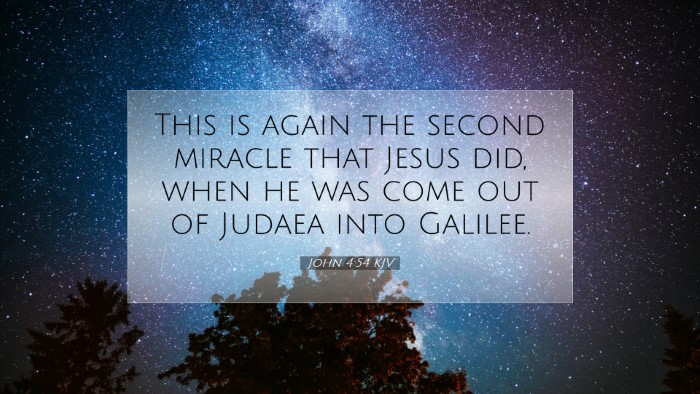Commentary on John 4:54
Verse Reference: John 4:54 - "This is again the second miracle that Jesus did, when he was come out of Judaea into Galilee."
Contextual Overview
The Gospel of John presents Jesus not merely as a historical figure but as the incarnate Word of God, imbued with divine purpose and power. John 4 records the significant encounter between Jesus and the Samaritan woman, leading to profound insights about worship, true belief, and the nature of the Kingdom of God.
Exegesis of John 4:54
In this verse, John emphasizes the miraculous signs performed by Jesus. This particular miracle refers to the healing of the nobleman's son, which serves as a demonstration of Jesus' divine authority and compassion. The significance of this miracle lies in its context – taking place after Jesus' dialogue with the Samaritan woman, it illustrates the fulfillment of His earlier promise to provide living water unto eternal life.
Public Domain Commentaries Insights
Matthew Henry
Matthew Henry highlights the importance of faith in this miracle. He notes that the nobleman’s faith was instrumental in witnessing the power of Christ. Unlike the Galileans who welcomed Jesus merely due to His miracles, the nobleman approached Jesus with reverence and trust, indicating that true faith often emerges from a place of dire need. Henry states, "Christ made this nobleman the instrument of his own cure, who himself had a cure to receive." This reflects on the broader principle that God often uses our circumstances to develop faith within us.
Albert Barnes
Albert Barnes, in his commentary, underscores the phrase "the second miracle," which serves to validate Jesus' ministry in Galilee. He articulates that this miracle demonstrates the continuity and extension of Jesus' ministry from Judaea to Galilee, thus reinforcing His divine authority over sickness and distance. Barnes states, "This miracle was designed to excite faith in His ability and willingness to heal." It marks a critical transition in Jesus' ministry, expanding His audience and deepening His impact among the people.
Adam Clarke
Adam Clarke offers a comprehensive view of the nobleman's faith, identifying it not just as belief in a miraculous act but as a deep, personal conviction in Christ's character. He emphasizes the nobleman’s persistence and humility in seeking healing for his son, which Clarke associates with the broader theme of intercessory faith. "The nobleman showed an earnestness that should characterize all who seek grace," Clarke posits. He draws attention to the notion that miracles often demand an active response from those seeking help – faith coupled with action leads to divine intervention.
Theological Implications
John 4:54 encapsulates important theological concepts worthy of reflection for pastors, students, and theologians:
- Faith and Works: The nobleman's faith exemplifies how genuine belief is often accompanied by action. He did not wait for healing to manifest in an ordinary way but sought out Christ personally.
- Christ’s Universal Ministry: The shift from Judaea to Galilee marks a significant expansion of Jesus’ ministry, highlighting His mission to reach all people, transcending geographical and social boundaries.
- The Nature of Miracles: Miracles in the Gospel of John serve as signs pointing to Jesus’ divine nature. They challenge readers to consider the implications of His authority and the necessity of belief in Him.
Application for Contemporary Believers
This verse and its associated commentaries encourage modern believers to explore the depth of their faith and reliance on Christ, especially in times of distress. It calls for an active, persistent approach to prayer and faith, particularly in intercessory contexts. The narrative invites all to witness the power of Christ, not as mere spectators but as actively engaged participants in His ministry.
Conclusion
John 4:54 not only recounts a miracle but serves as a reminder of Jesus' compassionate power and the nature of true faith. As the second miracle, it reinforces the continuity of Jesus' mission while offering profound truths about reliance on God's divine care and intervention. For pastors, students, and scholars, this verse stands as an invitation to deepen their understanding of faith, as they draw nearer to Christ, the source of living water and everlasting life.


